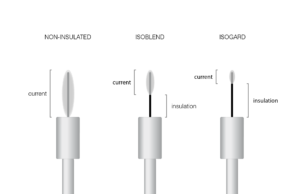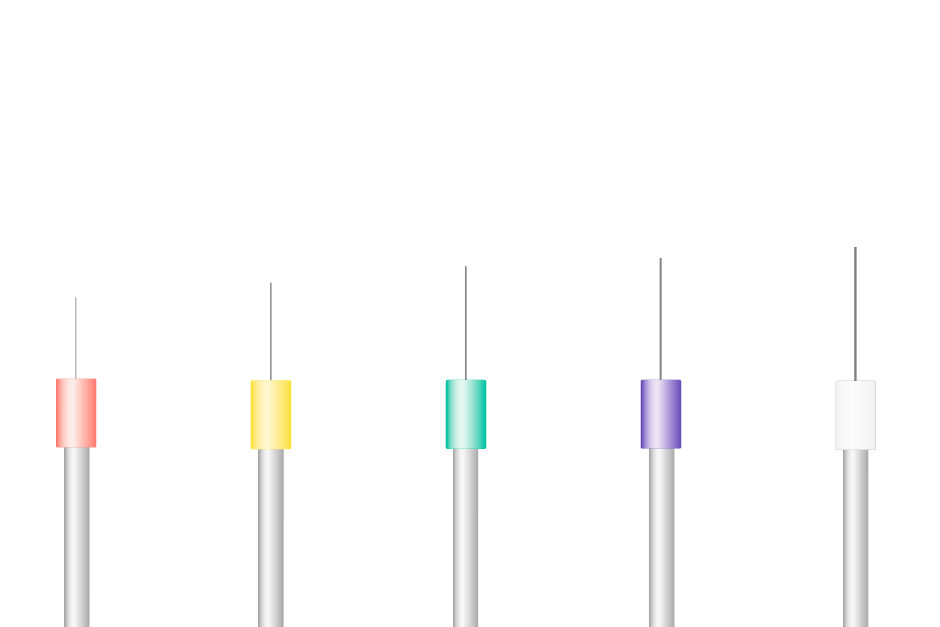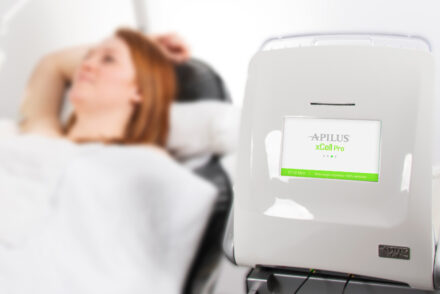Although they are very small instruments, probes are an integral part of an electroepilation treatment and can have a considerable impact on the latter. However, it can be hard to find your way around all the available options and use the right probe with every client. We are here covering this subject to help you choose the right probe for every treatment, in order to maximize results and client satisfaction.
Insulated or non-insulated?
An insulated probe is covered with an insulating material and leaves a portion of the tip of the probe bare. That bare portion diffuses the current inside the hair follicle. The Pro-Tec probes use medical grade heat-resistant Teflon and offer two types of insulation that can adapt to any situation: IsoGard (bottom ¾ of the probe is insulated) and IsoBlend (bottom half is insulated).
The use of insulated probes is becoming more popular and is highly recommended. With insulated probes, the emitted energy is concentrated at the base of the follicle, where the germinative cells are located. By more precisely targeting the desired destruction area, the efficiency of the treatments will be superior and you’ll be able to lower your parameters, hence increasing your client’s comfort. Moreover, the insulation reduces heat diffusion and keeps it from reaching the skin’s surface, protecting it from cutaneous reactions. Since the heat is less largely diffused in the tissues, the use of insulated probes require more precision upon insertion in order for the energy to be directed on the right spots, the dermal papilla and the bulge.
Non-insulated probes are less and less used, mainly because of comfort and skin protection. Since the whole probe conducts the energy, it is spread all the way up to the skin surface. However, since the energy flows along the entire length of the hair follicle, the non-insulated probe forgives a little bit more faulty insertions.
One-piece or two-piece?
Made up of one piece, the part of the one-piece probe that is inserted in the hair follicle is the prolongation of the shank. Of conical shape, it is fine-tipped and rigid. Indeed, it is that particular shape that induces a variation of the probe’s diameter. Its use requires experience and vigilance because its rigidity makes it hard to feel the resistance that indicates the electrologists that she has reached the bottom of the follicle or that she is in a faulty insertion angle.
The two-piece probe is of cylindrical shape and is maintained in the shank by a crimping technique. The main advantage of a one-piece probe is the flexibility its shape gives it. Since the probe is independent from the shank, it slides more easily inside the follicle and, when performing difficult insertions, it allows the electrologist to feel the resistance and correct her insertion.
Calibre and type of shank
The calibre of a probe varies according to each brand’s standards. In electroepilation, Pro-Tec probes use calibres between 1 and 5, 1 being the smallest and 5 being the biggest. The choice has to be made with regards to size and depth of the hair, as well as the size of the ostium. Generally, the finer the hair, the smaller the calibre. For example, a very fine hair on a woman’s upper lip can be a size 1 or 2, whereas a coarse hair on a man’s beard can be a size 4 or 5.
There are two types of shanks : F and K. The type of shank to use is determined by the probeholder and the difference is in the shank size: F is slightly bigger than K. However, the size of the probe itself (the needle) remains the same. In fact, the use of one or the other doesn’t affect the treatment and is mainly relevant to country standards. For example, in North America, we mainly use F shanks for electroepilation, whereas K shanks are used for thermocoagulation. In some countries, like France and Australia, K shanks are used for electroepilation.
Unique features
For efficient, safe and comfortable treatments, Pro-Tec probes offer to electrologists unique features.
- SecurGard – Each probe is individually wrapped and its packaging guarantees that it will be sterile for five years.
- MicroGard – the rounded MicroGard tip provides the softest insertions, while preventing the tip of the probe from piercing the hair follicle, since it also allows the electrologist to feel a resistance once she has reached the bottom of the hair follicle.
- SteriGard – always know you are using the right probe with the SteriGard colour code. Just one look to confirm which calibre you are holding. This collar also protects the probe against contamination, prevents shank and skin contact and shields the probeholder from cellular debris. It also facilitates the installation of the probe into the probeholder.
Always remember that your particular set of knowledge and skills is what makes you a hair removal professional. Don’t hesitate to ask questions and seek more precise information on the tools and equipment you are using, it will help you provide even better treatments to your clients!










1 Comment
The probe an electrologist uses can make a big difference. Thanks for sharing this information Jessica.